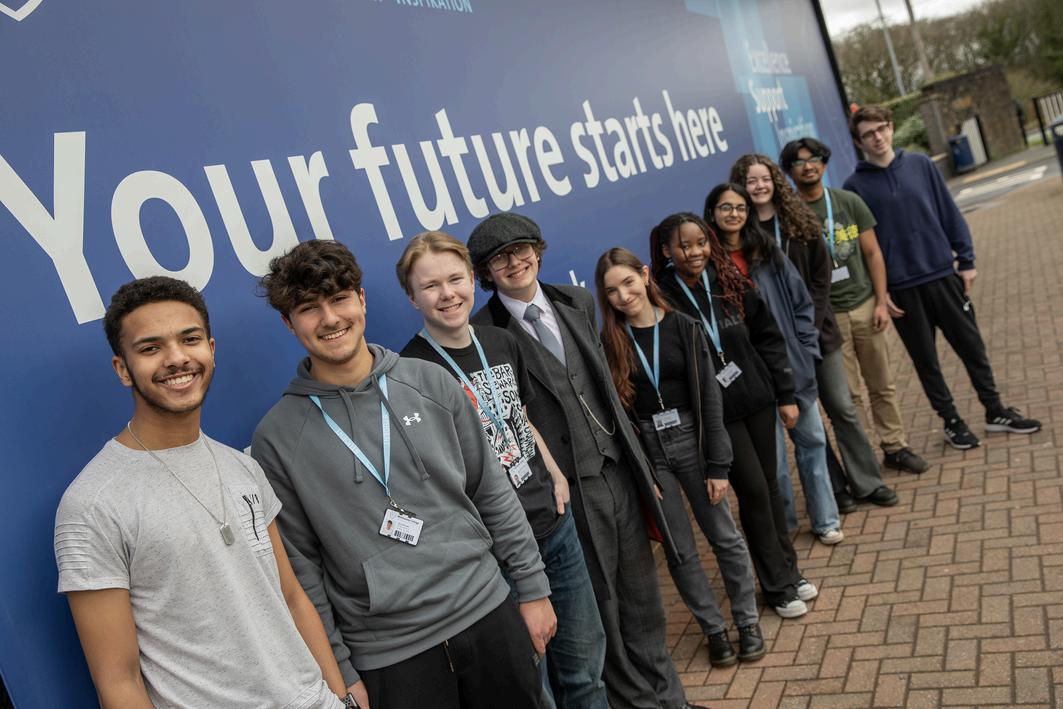
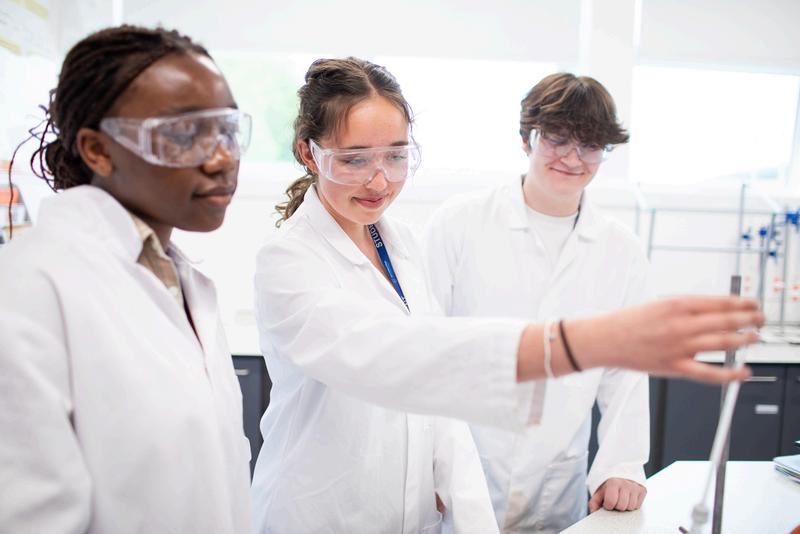


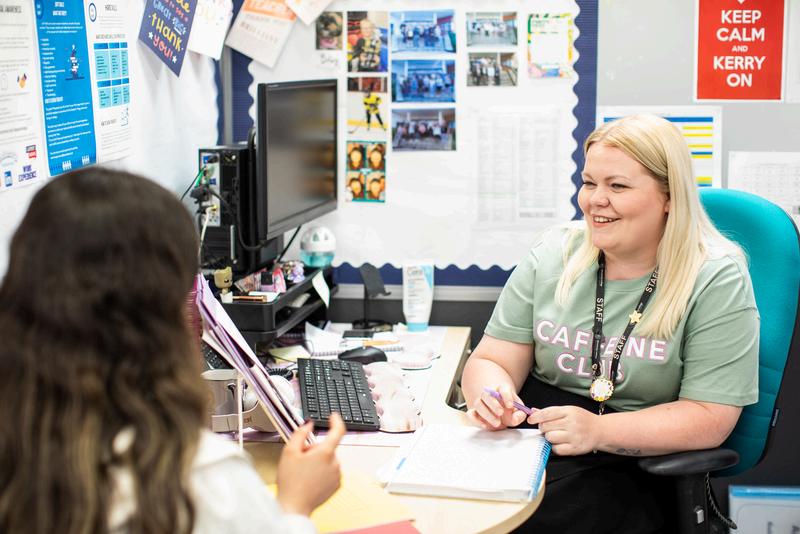
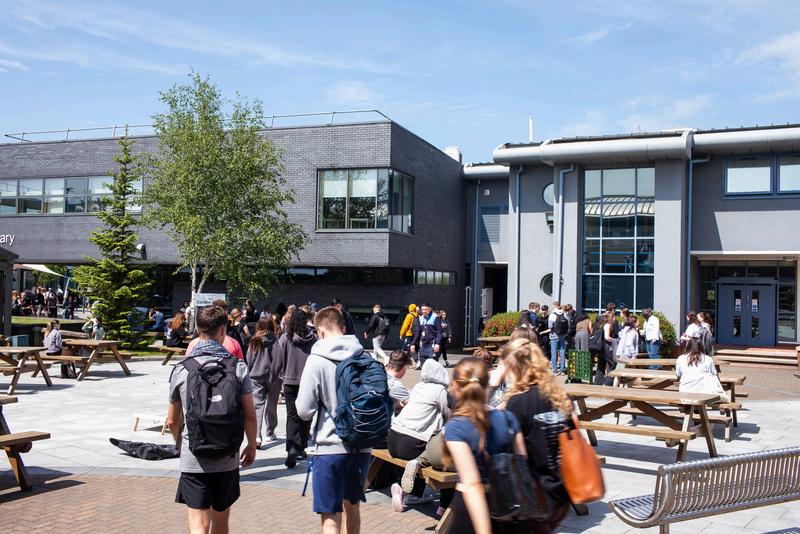
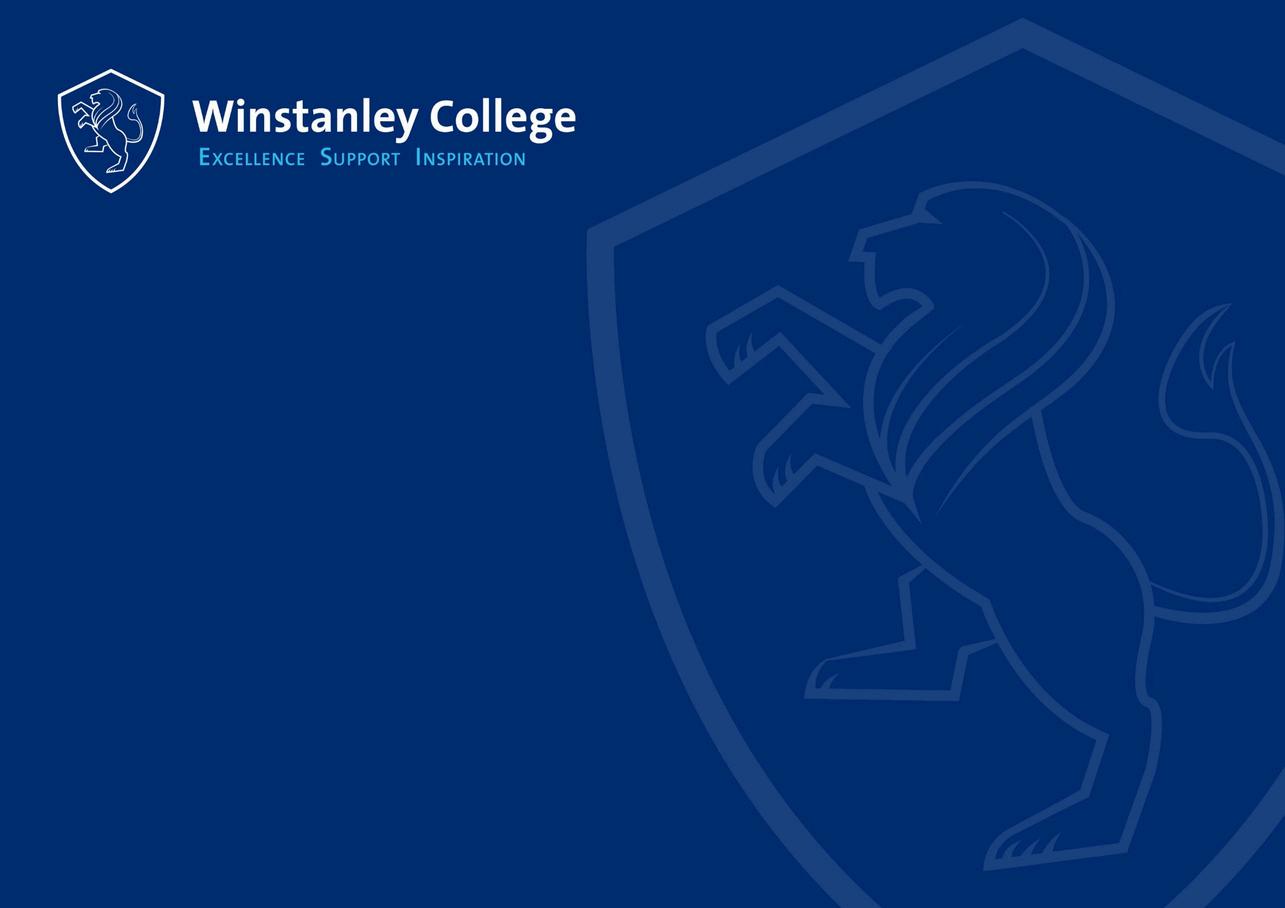








Winstanley College is a Sixth Form College and sits on the border of three local authorities: Wigan (Greater Manchester), West Lancashire (Lancashire) and St. Helens (Merseyside). There are currently 2200 students on roll from approximately 70 local schools who study A-level and vocational programmes with a very small provision resitting GCSE English and Maths [1].
A-levels constitute approximately 70% of the College’s provision The remaining 30% comprises vocational courses The College specialises in STEM (Science, Technology, Engineering and Mathematics), digital and creative provision, which aligns with the local need in Wigan and the Greater Manchester LSIP (Local Skills Improvement Plan). Specifically 38% of College provision is Science, Engineering and Maths and a T-level in Digital Media was introduced in September 2024. The College currently employs 192 staff (95 teaching staff, 97 support staff)
Currently, around a quarter of College students are from disadvantaged postcodes. Based on the most available DfE (Department for Education) figures, Progress 8 and Attainment 8 data position the local area in the ‘C’ quartile banding (ranked 92/151 nationally). This shows the College enrols a high proportion of students with relatively modest performance at Key Stage 4.
However, at Key Stage 5 the local area is positioned in the ‘A’ quartile (ranked 35/151 nationally) Winstanley College is a major contributor to this success, reflecting the College’s skill in harnessing the ability of young people many of whom underperform or achieve modestly at GCSE to achieve outstanding outcomes in their courses.
Therefore, the College has a local and national reputation as a very high-performing Sixth Form College Its most recent Ofsted inspection was in in January 2025, where it was rated ‘Outstanding’ with no significant areas of weakness identified [2]. In November 2024, it was named ‘Most Inspirational Sixth Form and College at the Educate North Awards.
Each year, approximately 80% of students progress to university. Since 2022, 829 Winstanley students have received offers to study STEM subjects at undergraduate level Of the cohort sitting external exams in Summer 2024, 41% progressed to Russell Group universities. The College is a HE+ centre for Cambridge, delivering access programmes for over 180 Winstanley and other Sixth Form students every year.
Significant numbers of Winstanley students progress to higher (Level 4 and 5) and degree (Level 6 and 7) apprenticeships with companies such as the BBC, Barclays, GCHQ, the NHS, Sellafield and Siemens The College is also making a significant contribution to the Greater Manchester LEP (Local Enterprise Partnership) priority to increase skills in advanced manufacturing.
[1] Further information on demographics and market context is set out in Appendix 1. [2] Winstanley College Ofsted inspection report, 2025


Finances have remained robust, with a ‘Good’ Financial Health rating forecast for the period covered by this Strategic Plan. However rising costs has increased the possibility that the College may need to implement restructuring work in the second half of the decade, should funding levels beyond the spending review period be frozen or not rise in line with inflationary pressure. There is also uncertainty regarding the outcome of future pay settlements, changes to National Insurance and the National Minimum Wage, and the funding of increased employer contributions to the Teachers’ Pension Scheme in the remainder of this decade.
The College also recognises it is essential to prioritise sustainability to secure the well-being of current and future generations. The College intends to implement an Environmental Sustainability Strategy to set out how it will respond to its responsibility to prepare students for the challenges and opportunities they will face with the appropriate knowledge, skills and pastoral care.
Winstanley College’s key strategic partners include local schools and colleges; local, regional and national employers; HEIs (Higher Education Institutions), many Russell Group universities (including Oxford and Cambridge); Wigan Council; Greater Manchester Combined Authority; the Wigan Institute of Education Partnership (which offers initial teacher training with seven partner schools); numerous teacher training providers (including Edge Hill Manchester Metropolitan and Bolton Universities); and the North-West Maths Hub (where the Principal sits on the Board).
In addition to its Strategic Plan, the College produces an Annual Accountability Statement [3], which is published on its website. This reflects the strategic priorities as set out in this document. Additionally, the College produces a set of Key Performance Indicators each year, an annual Self-Assessment Report, a Cross-College Improvement Plan and actively reviews its Risk Register.
The ambition of the College is to maintain the highest academic achievements in the face of continued external uncertainty over the remainder of this decade. Consequently, upholding Winstanley’s status as the leading provider of inclusive highquality education to young people in Wigan and the surrounding areas, whilst delivering the curriculum in a vibrant, sustainable campus, are key underlying elements of this Strategic Plan, which covers the period 2025-2028
[3] Annual Accountability Statement

Mission:
The mission of Winstanley College is to achieve academic excellence in a supportive and inspiring learning community.
To achieve its mission for the next three years the SLT (Senior Leadership Team) has undertaken a SWOT analysis [4].
This SWOT analysis establishes that the College is currently performing outstandingly well, with outcomes for students being well above national figures and students progressing to exceptional destinations in the next phase of their education and training This is against a backdrop of internal pressures linked to accommodation and social/study space for students, external funding constrictions and the ‘cost of living crisis’.
As a result of this SWOT analysis, the key planning assumptions underpinning this Strategic Plan centre on the following six themes:
Quality
The need to deliver outstanding educational provision, guidance and support to students, raising their aspirations to reach the best possible destinations they can.
Culture
The importance of being an inclusive College, which prepares students for life in modern Britain as responsible, active citizens who understand and respect diversity and inclusion.
Safety and Wellbeing
The requirement to safeguard and promote the health, safety and positive wellbeing of all who study and work at the College.
Innovation
The importance of striving for continuous improvement to position the College as one of the best Sixth Form Colleges in the country and to ensure staff have opportunities to develop as outstanding professionals
Finance and Sustainability
The need to manage the College’s finances, estates and resources effectively and ethically under Managing Public Money guidelines, to achieve best value and the best possible experience for students, while limiting the College’s environmental impact.
Partnerships
The need to develop and maintain strong relationships with stakeholders such as schools, universities, employers and the local community.
[4] A digest of the College’s key strengths, weaknesses, opportunities and threats is summarised in Appendix 2

To fulfil the College’s mission for the period 2025-2028, Winstanley College has developed the following six Strategic Priorities:
To retain the College’s reputation as a lead provider in local area for student outcomes and one of the topperforming Sixth Form Colleges in the country
Achieve student outcomes above national figures for pass rates A*-B grades (A-lev and D*-D grades (vocational), retention and achievement rates
Achieve ‘red’ value added in at least 75% of subjects
Close all achievement gaps between cohorts of students so there is no more than on Alps (Advanced Level Performance System) grade difference between student coho
Support students with special educational needs and/or disabilities (SEND), includin those with high needs, to plan individualised learning which helps them achieve in lin their peers
Incorporate Wigan Council’s Economic Strategy and Greater Manchester LSIP [5] in curriculum design and delivery
Meet local, regional and national skills needs through a ‘Gatsby benchmark’ complian careers and work experience strategy, ensuring all students have access to ‘level six qualified CAIG (Careers Information Advice and Guidance) and opportunities to obta meaningful experiences of work
Meet local and regional skills needs through the introduction and delivery of a wider portfolio of vocational subjects
Embed literacy strategy based on disciplinary literacy, oracy and reading in all schem work
Create independent learners through the ‘265 strategy’, which embeds Vespa (Visio Effort Systems Practice Attitude) principles and continues to improve student outco
Meet the needs of all students through clear and robust support/access arrangemen which are reviewed regularly with individuals and their families
Achieve a successful Ofsted outcome under the new (Nov 2025>) education inspec framework.
[5] The local and regional skills context is outlined in Appendix 3.

To be an inclusive and diverse C prepares young people to be res who understand and respect Bri
Obtain outstanding attendance and punctuality develop students’ employability skills
Deliver a high-quality Guidance programme of le modern Britain
Embed British Values in all schemes of work and Values in action e.g. via the Student Union
Be responsive to ‘student voice’ and ‘parent/car as appropriate
Achieve high student participation in ESI (Excell activities, recorded on students’ ILPs (Individual Embed Vespa learning behaviours in all scheme
Promote FREDIE (Fairness, Respect, Equality, Div the College and further strengthen the EDI Steer
Meet the needs of students with special educat including those with high needs, through informa throughout their course, to plan for individualise Ensure all College buildings are accessible to all Apply for and attain the ‘Investors in Diversity’ A
"Students describe the College as one big community, which they are immensely proud to belong to. They enjoy attending College and find the environment welcoming, inclusive, caring and friendly." (Ofsted, 2025)
"Students feel understood, respected and cared for. They say that everyone embraces and celebrates difference and that they can be who they want to be." (Ofsted, 2025)

Safeguarding of students to continue to be the Safeguarding topics to be covered through the responsive to up-to-date and emerging issues
Share best practice through network and multi Support for mental health and wellbeing to be a complete their programme of study
Health and safety culture to be a key element o Obtain high (85%>) satisfaction rating from stu recommend the College to others’
Continually review support and access arrange educational needs and/or disabilities (SEND) in their parents/carers informed to ensure they g them to successfully complete their programm
Staff wellbeing to be a top priority by continuin Scheme and further wellbeing and training opp Have an ‘open door’ policy at SLT level and imp views of staff in focus groups to be responsive
Obtain high (85%>) satisfaction rating from sta recommend the College as a place to work’
"Students benefit from highly effective support systems that keep them safe. They are comfortable talking to members of staff and to seek support when they need it. Staff deal with concerns swiftly and very effectively." (Ofsted, 2025)
"Leaders ensure that all staff working with students with high needs have specialist training in areas such as neurodiversity, autism awareness and manual handling." (Ofsted, 2025)

To pursue a culture of continual im success, and to be at the forefront College sector
Identify appropriate Local Enterprise Partnerships (LE Combined Authority and identify emerging regional s talent pipeline
Work with employers to develop innovative industrycurriculum
Strengthen leadership capacity in the College to sup senior leadership roles
Implement Co-Chair model to support succession pl
Recruit high-quality Governors to support progressio Chair level
Invest in IT on a year-by-year basis, so that students quality WiFi and computer facilities
Invest in software, training and support to strengthen attack
Further develop the quality assurance system of teac improvement plans are evidence based
Further develop the CPD (Continuous Professional De teacher led research and be innovative in classroom
Ensure all staff are aware of implications of AI (Artific practice in the workplace and to comply with new leg Enhance the Marketing Strategy to give the College a Ensure the Marketing Strategy allows the College to d so that this maximises student numbers at a time wh increase
Win at least three external awards and/or charter ma this Strategic Plan.
"Leaders have very recently introduced a T-level in media, broadcast and production to meet local skills shortages in this sector. Leaders have invested significantly in relevant industry-standard equipment to ensure that they teach students the skills that they need for local employment."
(Ofsted, 2025)

To effectively manage the recruitment of students and the College’s estate to ensure long-term financial sustainability
Meet or exceed student recruitment targets agreed by Governors in the years covered by this Strategic Plan
Achieve at least a ‘Good’ Financial Health rating for the period of this Strategic Plan
Students have access to affordable private transport links to get them to and from the campus
Attain permanent classroom solution for those subjects currently taught in portacabins
Improve social and study space for students
Develop the catering offer to be fully responsive to the needs of students and staff
Co-locate support areas of the College as far as possible
Build a larger and better-equipped Library to support the academic climate and ethos of the College
Implement a robust climate action plan in line with statutory government requirements
Maximise College income through use of investment platforms
Supplement core funding grant with non-DfE income.
"Leaders have invested significantly in relevant industrystandard equipment to ensure that they teach students the skills that they need for local employment." (Ofsted, 2025)
"Students develop additional skills through working on community projects. For example, they have presented their initial ideas on how they can support the regeneration of the local railway station. This has helped them to develop relevant skills, such as creative thinking, problem-solving, and budgeting." (Ofsted, 2025)

To work effectively with a range of key internal and external stakeholders to enhance the work of the College and raise its profile as an outward-facing organisation
Demonstrate a commitment to Wigan Council’s ‘Progress with Unity’ key missions by working with Wigan school and college leaders to deliver the best outcomes for young people in the local area
Establish Employer and Stakeholder Boards to advise and enhance the curriculum offer in College
Develop a Multi-Academy Trust with key partners, including DfE and Regional Directors
Meet local skills needs through partnership working with key local stakeholders, including Wigan Council and Greater Manchester Combined Authority and local and regional employers
Engage with students, parents/carers and alumni who have a local, regional and national profile
Regularly consult with the local community, including ‘Brighter Better Orrell’ Have ongoing meetings with local MPs to influence Government policy
Work with local Police and other relevant bodies to safeguard members of the College community
Conduct annual peer review of the Self-Assessment Report conducted with ‘critical friends’.
"Leaders work with a wide range of employers and other stakeholders, including the Greater Manchester Chamber of Commerce, to identify and meet local, regional and national skills needs." (Ofsted, 2025)
"Leaders have developed effective relationships with a range of partners to ensure that their curriculums align to local, regional and often national needs. Partners provide curriculum content advice, workshops, visits, live projects and professional development opportunities for staff."
(Ofsted, 2025)


The delivery of this Strategic Plan translates into specific structures, policies, and operating and development plans, each having clear levels of accountability.
These include:
Most recent Ofsted report
Annual Strategic Conversation with the DfE
Annual Accountability Statement
External review of Governance and Action Plan
Board and Committee structures
Organisational structure
Key Performance Indicators [6]
Senior Post-Holder and Senior Leadership Team targets
College Self-Assessment Report (SAR)
Cross-College Improvement Plan (CCIP)
College Risk Register
Annual Budget and Three-Year Financial Forecast
Accommodation Strategy
Marketing Strategy
Quality Management Policy and Strategy
Teaching and Learning Strategy
Environmental Sustainability Strategy
Skills Agenda Strategy
Admissions Policy
Individual College policies
Departmental SARs and Quality Improvement Plans (QUIPs)
Internal inspections
Specific papers and executive summaries for Board and Committee meetings and SLT meetings
Minutes of SLT meetings and minutes of meetings with middle leaders.
[6] Key Performance Indicators for 2024-25 are listed in Appendix 4.
The following key checkpoints will ensure the goals set out in this Strategic Plan are fulfilled as planned:
Annual setting, monitoring and review of curriculum and academic Key Performance Indicators (KPIs) by the Board
Annual setting, monitoring and review of Senior Post-Holder and SLT performance management targets by the Governors and Principal
Annual setting of performance management targets for staff irrespective of their role in College, by College leaders and managers
Annual update of Strategic Plan (reviewed September 2025, 2026, 2027)
Annual validation and submission of the Accountability Statement
Annual validation of College SAR (each November by the Curriculum and Quality Committee – including external ‘critical friend’ on the panel)
Annual mid-year review of Cross-College Improvement Plan (each February/March by the Board)
Annual mid-year review of Departmental QUIPs (by SLT)
Review of Risk Register by SLT and appropriate Governance Committee at each Committee and Board meeting
Tracking documents pertaining to each Governance Committee and Board meetings
Governor visits and reports
The following key stakeholders are central to ensuring the College achieves the priorities as set out in this Strategic Plan:
Internal:
Students
Parents and carers
Support staff
Teaching staff
College managers
Middle leaders (including Heads of Faculty/Department, Assistant Heads of Department)
The Senior Leadership Team
The Board of Governors.
External (local/regional):
Alumni
Flinders Chase (advice and solutions for construction projects)
Greater Manchester Combined Authority
Local employers and businesses
Local MPs
Local police
Local residents/community (including ‘Brighter Better Orrell’)

Local schools
Local transport companies
Local and regional colleges
Local and regional universities
Mellors (catering company)
NWSFC (North-West Sixth Form College Principals’ group)
WASCL (Wigan Association of School and College Leaders)
Wigan Council, including local Councillors
Wigan Chamber of Commerce
Wigan Employee Healthcare Support Service
Wigan Prevent
Wigan Institute of Education.
External (national):
Alps
DfE (Department for Education) and ESFA (Education and Skills Funding Agency)
DfE Regional Director(s).
JISC (Joint Information Systems Committee)
Judicium Education (Data Protection service)
Maple Group colleges
National employers and businesses
National universities (including Oxbridge)
Ofsted
SFCA (Sixth Form Colleges Association)
Sport England.
The College recruits students from a wide geographical area spanning a 20-mile radius and including approximately 70 secondary schools Just over 47.0% of students come from 19 schools in the Wigan borough two of which have sixth forms.
Most of the other 53.0% of students come from a further 56 schools outside the borough and some from as far away as Southport and Salford. Of the 18 Wigan schools the College recruits from, four are Catholic institutions and these contribute 270 or 26.0% of in-borough enrolments.
This makes the College heavily dependent on affordable transport routes The College currently subsidises transport costs for approximately 750 students.
Wigan itself is well-served by public transport, with two train stations and a bus station located within the town centre Public transport links are good into central Wigan, but Winstanley College sits 8 km from the town centre, so there are few public services serving the College directly
Other local transport hubs are located further afield, with bus stations at Leigh (20 km), Bolton (25 km) and Ormskirk (18km) as well as larger rail hubs at Bolton (26 km) and Warrington (23 km)
The introduction of the Greater Manchester ‘Our Pass’ for students (which enables free bus transport) is beginning to impact on recruitment patterns to the College but of more significance from September 2022 was the impact of rising inflation and fuel costs impacting on household finances
Therefore the need to offer a generous subsidy to families to ensure that travel costs are affordable to students has put considerable pressure on the College budget in recent years and will continue to do so for the period covered by this Strategic Plan.
Empty or otherwise:
School Academyornot Ofstedgrade
Bedford High Schoo, Leigh (28) No 2 (October 2023)
Cansfeld Hgh School Ashton-n-Makerfeld (42) No 2 (June 2024)
Cucheth Hgh School (100) No 2 (November 2022)
Goborne High Schoo Goborne (67) No 1 (June 2024)
Lathom Hgh School - A technica Co ege (8) No 2 (June 2022)
Shevington High Schoo Shevngton (53) No 2 (March 2022)
Westhoughton Hgh School (20) No 3 (May 2023)
Schoo
Academyornot OfstedGrade
Atherton Communty Schoo, Atherton (10) Academy Education Partnership Trust 2 (January 2024)
Birchwood Community Academy Trust (10) Academy (One Community Trust) 2 (December 2024)
Byrchal High Schoo Ashton-n-Makerfield (84) Academy Makerfied Academy Trust 2 (September 2022)
Burscough Prory Academy previousy Burscough Science Colege (37)
Co-op Academy Wakden previousy Wakden Hgh School (90)
Dean Trust Wgan (15)
Deyes High Schoo (11)
Academy (part of Endeavour Trust) 4 (November 2017)
Academy (part of Co-op Academes Trust) 3 (January 2016)
Academy 3 (October 2023)
Academy (part of Lydate Learnng Trust) 2 (September 2024)
Fred Longworth Hgh School Tydesley (80) Academy converter 2 (October 2022)
Hawkley Hal Hgh School Worsley Mesnes (76)
Academy (part of Rowan Learning Trust) 2 (November 2024)
Hope Academy (66) The Lverpoo Joint Cathoic and Church of Engand Academy Trust 3 (November 2024)
Ormskrk Schoo (46) Endeavour Learning Trust 2 (January 2025)
Outwood Hindley prevously Hindey Hgh School Hindey (46) Outwood Grange Academy Trust 2 (March 2024)
Rainford High Technology Colege (53) Everyone Matters Schoo Trust 2 (September 2021)
Rose Bridge Academy nce-in-Makerfield (9) Academy (part of Dean Trust) 3 (March 2023)
Standish Community High Schoo Standsh (119) Mosac Academy Trust 2 (October 2021)
The West Leigh Schoo, Westleigh High Schoo, Legh (24) Academy (part of Shaw Educationa Trust) 2 (November 2022)
Up Holand High Schoo (56) Everyone Matters Schoo Trust
Previousy a 2 but no inspection since academsaton n Jan 24
Al Sants Cathoic Hgh School Kirkby (63)
2 (November 2021) Lowton C of E High Schoo Lowton (32)
Our Lady Queen of Peace Cathoic Engineering Colege (36)
St Bedes RC Hgh School Ormskrk (111)
2 (March 2023)
4 (December 2022)
2 (November 2024)
St Edmund Arrowsmth Cathoic High School Ashton-in-Makerfied (108) Denominated maintaned school 2 (November 2021)
St John Fsher Catholc High Schoo (23) Denomnated maintaned 2 (January 2021)
St Josephs RC High Schoo Horwch (14) No 4 (December 2022)
St Mary’s Cathoic Hgh School Astey (6)
(October 2024)
St Peters Cathoic Hgh School Orrel (115) Denominated maintaned school 2 (Apri 2024)
The Deanery C of E Hgh School Wgan (62) Denominated maintaned school 2 (May 2022)

2023-24 Winstanley College student numbers are shown in brackets in the first column alongside information showing whether the school id an academy (column 2) and its most recent Ofsted grade (column 3)
Key:
Ofsted grade 1 Outstanding
Ofsted grade 2 Good
Ofsted grade 3 Requires Improvement
Ofsted grade 4 Inadequate

The College competes directly for students with the following post 16 providers:
Bolton Sixth Form College – Ofsted Good (distance from Winstanley 24 6 km)
Cardinal Newman College (Catholic SFC) – Ofsted Outstanding (distance from Winstanley 32.1 km)
Carmel College (Catholic SFC) – Ofsted Outstanding (distance from Winstanley 12.8 km)
The Deanery High School and Sixth Form - Ofsted Good (distance from Winstanley 7.5 km)
Loretto College - Ofsted Outstanding (distance from Winstanley 43 km)
Ormskirk School & Sixth Form – Ofsted Good new framework (distance from Winstanley 14 km)
Priestley Sixth Form College (Academy) – Ofsted Good (distance from Winstanley 32 km)
Pendleton Sixth Form College - Ofsted Requires Improvement (distance from Winstanley 37 km)
Rainford High School & Sixth Form – NA (distance from Winstanley 11 km)
Runshaw College (FE and Sixth Form) – Ofsted Good (distance from Winstanley 25 1 km)
St John Rigby College (Catholic SFC) – Ofsted Outstanding (distance from Winstanley 4 1 km)
St Mary’s Catholic High School Leigh – Ofsted Good (distance from Winstanley 21.5 km)
West Lancashire College – Ofsted Good (distance from Winstanley 8.0 km)
Wigan and Leigh FE College – Ofsted Good (distance from Winstanley 7.7 km).
"Where stakeholders identify skills shortages, leaders work effectively with leaders of the other local colleges to plan and coordinate new courses to fill the knowledge and skills gaps in the region." (Ofsted, 2025)

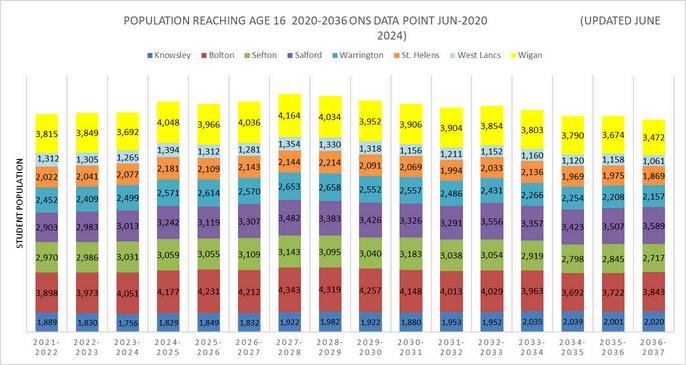
ONS data can be used to provide an estimate for the number of pupils reaching 16 in each academic year who are living in the Local Authority areas close to the College. This data shows the entire population, including those who may travel out of one Local Authority to attend a school. This does introduce some level of uncertainty when using the data to predict enrolments for future years. However, despite this, the overall trend should be a good approximation of how the population will ‘ebb and flow’ over the coming years. When looking at the Local Authorities which border the College, a clear increase in total population of potential students increases up to the academic year 2027-2028. After this point there is a steady decline.
The College recruits just over 47.0% of its students from Wigan schools. Data from the Department for Education shows the number of school pupils in the Wigan borough by age group. This data can be used to estimate the maximum number of school pupils who could potentially enrol at Winstanley College due to being 16-years-old at the time of enrolment in August of each academic year. For example, there were 3810 Year 11 pupils in the academic year 2021-2022 in Wigan schools. This was predicted to decrease to 3714 Year 11 pupils for the year 2022-2023. This will plateau at approximately 4000 students up to the academic year 2026-2027, before gradually declining. There are slight differences between the numbers of pupils in Wigan schools compared with the number of students registered as living at a Wigan address, but these differences are small.
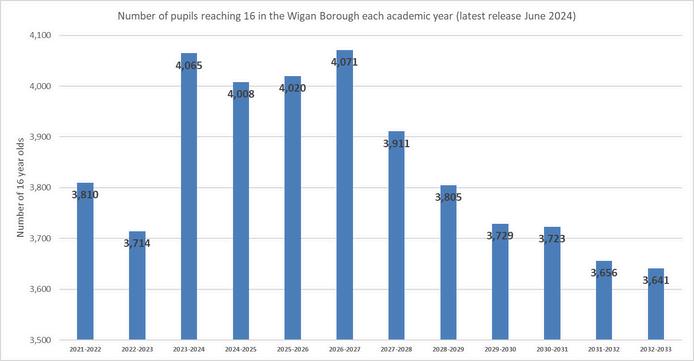
Source: gov uk Schools pupils and their characteristics Published June 2024 and updated September 2024


by the red line.) It must be noted that these predictions are only based on raw numbers of potential students and so cannot account for factors such as students not meeting the entry requirements of the College.

Source: ONS Mid-year population estimates UK June 2020 – published June 2021 and updated June 2024

As outlined previously, approximately 47.0% of the College’s recruitment comes from students living and studying in Wigan. Breaking down the students enrolled at the College by Wigan and non-Wigan schools, trends of applications, and offers and enrolments for the past five years, can be seen below. When predicting any further enrolments, it is worth noting that the year 2022-2023 saw particularly healthy recruitment and in the context of a wider picture may be seen as something of an anomaly. The figures under the ‘Day 42’ headings refer to the actual number of Year 12 students who were/are still enrolled in College by the time of the first census.


Using this ‘application to offers’ data, a range of predictions for Year 12 enrolments for the next few years can be made by taking the College’s current data and applying conversion rates to the numbers of potential students residing in the Local Authorities. The data shows that it is difficult making predictions based on averages due to the ‘peak like’ nature of enrolment since 2020. As a result, a range of possible projected enrolment are shown here.
As outlined previously, approximately 47.0% of the College’s recruitment comes from students living and studying in Wigan. Breaking down the students enrolled at the College by Wigan and non-Wigan schools, trends of applications, and offers and enrolments for the past five years, can be seen below. When predicting any further enrolments, it is worth noting that the year 2022-2023 saw particularly healthy recruitment and in the context of a wider picture may be seen as something of an anomaly. The figures under the ‘Day 42’ headings refer to the actual number of Year 12 students who were/are still enrolled in College by the time of the first census.


To achieve its mission for the coming years, the Senior Leadership Team has undertaken a SWOT analysis. A digest of the College’s key strengths, weaknesses, opportunities and threats is summarised as follows:
Rated ‘Outstanding’ by Ofsted, most recently in March 2025
High-performing provider of A-levels and vocational programmes according to national figures
Very strong reputation in the local area for excellence
Comprehensive A-level and vocational curriculum offer which meets local priorities and students’ needs
Outstanding provision for students with high needs
Excellent pastoral provision, with students able to access a wide range of support tailored to their individual needs
Very effective arrangements for safeguarding, which allow concerns and issues to be addressed in a timely way by welltrained and qualified staff
Strongly embedded framework for students’ mental health across both curriculum and pastoral areas, including outstanding internal counselling support service for students
Outstanding extra-curricular activities, which complement students’ academic studies and cultivate their moral, social and physical development
Well-embedded careers programme with a clear commitment to providing careers education, information, advice and guidance that meets the needs of all students
Strong links with employers within the curriculum and in the College’s Careers programme
Outstanding destinations, with Guidance, Careers, Apprenticeship and Employability, Medicine, Dentistry and Veterinary Science (MDV) and Oxbridge Programmes enabling students to progress to top universities, higher-level apprenticeships and employment
Effective contribution to addressing skills gaps, locally, regionally and nationally, with students prepared effectively for the world of work
Well-behaved students who are motivated to attend their courses
Inclusive College with a diverse student community who are aware of and display a strong commitment to British values
Vocal student voice with strong communication links to the Senior Leadership Team and the Governing Board
Well-qualified and committed staff, with a wealth of experience in successfully delivering A-level and vocational qualifications
Commitment to regular and ongoing staff training, which allows for subject mastery
Commitment to staff wellbeing through the performance management process and local Employee Healthcare Support Service
Sharing of good practice through two groups of sixth form providers
Strong partnerships with key stakeholders, including local schools and colleges, employers, HEIs, Wigan Council, Greater Manchester Combined Authority, teacher training providers, the North-West Maths Hub, etc.
Supportive and enquiring Governing culture, which is positive, challenging and demonstrates ambition, as evidenced by an external review of Governance carried out by Stone King in 2023-24
Current Financial Health rating of ‘Good’ and forecast for the duration of this Strategic Plan
Strong financial reserves which can be used to support capital development on site.
Student enrolments in 2024-25 did not meet the expected target and have pushed the College into a projected financial deficit
Self-Assessment Report (2023-24) shows that the academic performance of a small number of subjects needs to improve
Accommodation in areas of the campus needs improvement: social and study space for students needs increasing; temporary portacabins need replacing with a long-term solution; support areas are not co-located and scattered in different areas of the campus; the library is not fit-for-purpose and in keeping with the mission and ethos of the College Exams policy and linked policies need updating to ensure students with support/access requirements have their needs reviewed regularly throughout their two-year course
Attendance at Guidance sessions needs to improve to bring it in line with attendance within the curriculum Student participation in the Excellence, Support and Inspiration (ESI) Programme needs to further improve, removing barriers where low hours are recorded on some students’ Individual Learning Plan (ILP)

Development of a Multi-Academy Trust, which could deliver benefits and support to other educational establishments, either in the local area, regionally or nationally
Deployment of financial reserves to develop a new building to provide a permanent home for courses currently taught in the portacabins; further social space for students; a larger, better equipped library and which will allow for support functions to be co-located
Widen the curriculum with further vocational subjects which will link to the aims and objectives of the Greater Manchester Baccalaureate
Scope for further partnership work with key stakeholders, e g contributing to the development of the Greater Manchester Baccalaureate
Widen opportunities for external stakeholders to contribute to the design of the College curriculum
Further potential to tap into the quality and local, regional and national success of alumni
Provide further opportunities for students to engage in work experience, placements and experiences of work
Further development of the marketing strategy to ensure the College maximises student numbers during a period when competition for places will increase
Integrate AI to promote independent learning, wider accessibility and individualised learning and support
Achieve accreditation of the Investors in Diversity Award
Develop bespoke training and development for staff to cultivate a research-informed pedagogical culture in the College
Build on the College’s ‘265’ strategy to ensure all students demonstrate behaviours associated with the Vespa model of student success (Vision, Effort, Systems, Practice, Attitude).
The number of Year 11 students in Wigan schools will plateau at approximately 4000 students up to the academic year 2026-2027, before gradually declining. Therefore, competition for places from neighbouring school sixth forms and colleges will increase in the latter part of this decade
Current Government education policy which is yet unclear on the future direction of post-16 education
Office for National Statistics (ONS) reclassification of Sixth Form Colleges into the public sector which prevents the College from being able to borrow money to undertake a proposed capital expansion scheme, which is compounded by a lack of access to capital funds from Government
Institute for Fiscal Studies estimation that by 2027-28, the real value of government department budgets will have eroded due to inflation over the next few years, which assumes cuts to public investment could be needed in the second half of the decade
Rising staffing costs due to the likelihood of increased pay awards in future years, which will have to be funded by the College
No further increase beyond the current funding level, which could increase the likelihood of additional staff restructuring in the second half of this decade
The ‘cost of living crisis’, which is impacting on the College in many ways, e.g. rising energy prices, increased costs associated with refurbishment of the estate, students’ ability to be able to continue with their post-16 studies etc.
Cost of private transport for students, which risks becoming a novel and contentious transaction under Managing Public Money guidelines
Building work throughout the period covered by this Strategic Plan and its impact on the College, e.g. potential noise and disruption caused by building work to delivery of the curriculum and sitting of exams reputational damage in the local community whilst building work is taking place
Increasing risk of cyber attack
Environmental impact to student learning and the estate from global warming if action is not sustained to move to net zero emissions by 2038
Impact on students of disruption caused by the Covid-19 pandemic when they were in the early years of their education
Potential for poor mental health and wellbeing, and the detrimental effect this could have on students and staff
Increasing difficulty of recruiting and retaining high-quality staff at a time when further numbers are leaving the education profession
Rising prominence of safeguarding-related incidents within the student community and particularly outside College
The College’s proximity within an area of the country designated a high-risk area for potential knife and gun crime
As Winstanley College sits on the border of three local authorities – Wigan (Greater Manchester), West Lancashire (Lancashire) and St Helens (Merseyside)
– it has a commitment to addressing skills gaps in all three of these areas
Firstly, Wigan Council has recently refreshed its Economic Strategy and the College was a key strategic partner in the development of this, working alongside the two other Post-16 colleges in the local area:
The Council has also launched its ‘Believe in Your Future’ programme to ensure that students’ aspirations are raised in key sectors, leading to good jobs for local people; business growth to provide quality competitive employment; and pathways into rewarding work for everyone, regardless of ability of starting point Winstanley College piloted the programme for the Council in the 2023-24 academic year.
As a large number of students come from and go on to study and work in Lancashire and St Helens, the College is committed to addressing skills gaps as set out in each of their respective local plans:
Further to this the development of Wigan Council’s Economic Strategy is connected to the refreshed Local Skills Improvement Plan and Greater Manchester Industrial Strategy. This is designed to connect the opportunities in the borough to the broader opportunities across Greater Manchester:
The Greater Manchester Local Skills Report (Progress Report 2024) continues to reference the Frontier Sectors and Foundation Economy for the city region as highlighted below:

Additionally, the Greater Manchester Baccalaureate has been designed as an alternative for technical education, signposting young people to the subjects
Greater Manchester employers value most.
Qualifications are aligned to the sectors that are growing in Greater Manchester:
Digital and Technology
Health and Social Care
Creative, Culture and Sport
Financial and Professional
Engineering and Manufacturing
Construction and Green Economy
Education and Early Years



Appendix 5: Review of Strategic Plan 2025-2028
This will be completed in September 2025.
Review 1: September 2025
Outline any revisions or additions made to the Strategic Plan:
Strategy Priority 1: Quality - To retain the College’s reputation as a lead provider in the local area for student outcomes and one of the top-performing Sixth Form Colleges in the county
Criteria
September2025updateonachievementofStrategicPriorities
Strategy Priority 2: Culture - To be an inclusive and diverse College community which prepares young people to be responsible, active citizens who understand and respect British values
Criteria
September2025updateonachievementofStrategicPriorities
Strategy Priority 3: Safety and Wellbeing - To support students and staff in their development and wellbeing.
Criteria
September2025updateonachievementofStrategicPriorities
Strategy Priority 4: Innovation - To pursue a culture of continual improvement and success and to be at the forefront of the Sixth Form College sector
Criteria
September2025updateonachievementofStrategicPriorities
Strategy Priority 5: Finance and Sustainability - To effectively manage the recruitment of students and the College’s estate to ensure long-term financial sustainability
Criteria
September2025updateonachievementofStrategicPriorities
Strategy Priority 6: Partnership - To work effectively with a range of key internal and external stakeholders to enhance the work of the College and raise its profile as an outward-facing organisation
Criteria
September2025updateonachievementofStrategicPriorities
